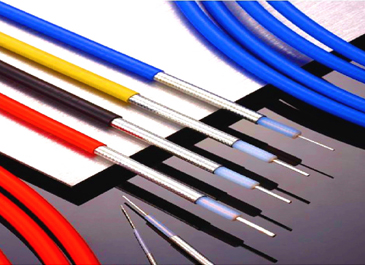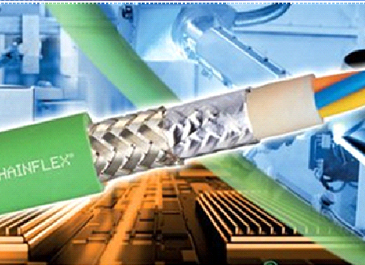Current status and future prospects of RF cable industry
Release time:2021-01-08 Number of Views:534
1、 Definition and classification of RF cable
1. Definition of RF cable
Radio frequency is the abbreviation of radio frequency, or "RF" for short. It is the abbreviation of a kind of high-frequency alternating electromagnetic wave, which means the electromagnetic frequency that can be radiated into space, and the frequency range is between 300kHz and 30ghz. Radio frequency cable is the general term for the cables that transmit electromagnetic signals or energy within the radio frequency range.
2. Classification of RF cables
According to the structure, RF cable can be divided into coaxial cable and symmetrical cable. The coaxial cable is composed of two concentric conductors with insulating layer between them and sheath. The signal transmitted by the inner conductor is shielded by the outer conductor to reduce the signal interference and ensure the transmission effect. Symmetrical cable is made up of two mutually insulated wires winding each other according to a certain specification, so as to offset the radiation between each other, reduce noise interference and ensure the effect of signal transmission; multiple symmetrical cables are combined to form a data cable.
According to the usage, RF cables can be divided into three categories: 75 ohm coaxial cable, 50 ohm coaxial cable and data cable. 75 ohm coaxial cable is mainly used to transmit wired video signal, 50 ohm coaxial cable is mainly used to transmit high-power wireless communication signal, and data cable is mainly used to transmit data signal.
2、 The purpose of the product
RF cable is mainly used in the field of wired and wireless communication, including radio and television communication system, fixed network communication system and mobile network communication system.
3、 Industry development status
According to a recent report released by International Market Research Institute technavio, the global RF cable market is expected to grow by US $2.7 billion from 2020 to 2024, with a compound annual growth rate of nearly 7%.
From a regional perspective, the Asia Pacific region will be the largest regional market for RF cables in 2019. It is expected that 49% of the market growth will come from the Asia Pacific region in the forecast period. China and Japan are the main markets for RF cables in the region. More and more broadband users and continuous investment in 5g technology will greatly promote the growth of RF cable market in the region. On the whole, the market growth in the Asia Pacific region will be faster than that in other regions in the forecast period.
According to the report, the continuous development of smart cities for effective management of assets and resources in the global economy is one of the key factors driving market growth. Governments are working with different IT solution providers, telecom network infrastructure providers and several others. For example, multinational companies including IBM, Microsoft, Cisco Systems and Schneider Electric are taking a number of initiatives and committed to developing IT solutions to develop smart cities.
The mission of smart city has also received more and more attention in emerging economies, including India, and plans to develop about 100 cities into smart cities. In the forecast period, factors such as the growth of smart city development will drive the RF cable market to grow at a compound annual growth rate of nearly 7%.
4、 Mode of operation
After years of development, there are three types of competitive enterprises in the RF cable Market: brand service providers, professional manufacturers and a small number of large comprehensive enterprises.
After years of development, large comprehensive enterprises have outstanding brand advantages and can provide overall solutions for downstream customers, such as Amphenol, Broadcom, CommScope, etc. Brand service providers use their knowledge of market segments to provide professional support and after-sales services to end customers, such as anixter (anixter International Inc.), graybar (graybar services, Inc.) and Wesco (Wesco international, Inc.). Professional manufacturers focus on product design, R & D and manufacturing, providing manufacturing services for large integrated enterprises and brand service providers. Other types of enterprises only have certain production and sales capacity, lack of design capacity, material and process research capacity, lack of professional support capacity and brand, or produce low-end products, engage in OEM production, product quality and performance compared with professional manufacturers, there is a big gap.
5、 The future development direction of the industry
(1) High frequency can achieve higher speed and provide more applications
The signal has a certain frequency when it propagates. The difference between the maximum value and the minimum value of the signal transmission frequency is called the bandwidth, that is, the width of the signal spectrum, also known as the frequency band. All kinds of signals are transmitted on different frequencies to avoid crosstalk. In the wireless field, the application field of RF cable can be divided into aviation communication, navigation communication, land communication, radio and television, radio navigation and other different services, and each service has a certain frequency band. In the field of cable signal transmission, 15 ~ 40MHz band is used to transmit telephone signal, 110 ~ 860MHz band is used to transmit TV signal, and above 860MHz band is used as standby band to realize more applications.
With the diversification and personalization of various communication applications, the communication network is required to have faster transmission speed, which is positively related to channel frequency band and signal power. Broadening the channel frequency band and realizing high-frequency network can effectively improve the data transmission speed and realize more applications. Therefore, how to adapt to the high-frequency transmission environment has become an important development direction of RF cables and related supporting products.
(2) It should meet the development requirements of environmental protection and energy conservation
High frequency signal has obvious skin effect. Therefore, the inner conductor of coaxial cable can be copper plated with iron or aluminum material, that is, copper-clad steel or copper-clad aluminum structure. On the one hand, it can reduce the weight of cable, on the other hand, it can save more than 70% of scarce copper resources. Through material improvement and process optimization, RF cable can achieve the same design performance with less raw material consumption. Through the structure and circuit design of the main body and amplifier module, the high frequency head can reduce the consumption of aluminum shell and the number of components, so as to achieve resource saving.
(4) The quality of RF cable is developing in the direction of low loss, consistency and anti-interference
When the signal propagates in the medium, part of the signal leaks or transforms into heat, so there will be loss, that is, signal attenuation. The signal attenuation is mainly related to the dielectric constant and signal frequency of the insulating medium. The better the insulation effect, the smaller the dielectric constant, the lower the signal attenuation. In the high frequency signal transmission system, the degree of attenuation will multiply, and the higher the performance requirements of the cable.
(5) Enterprises need to comply with the high requirements of production technology and technical standards
Copper clad steel for high-quality RF cable should be evenly plated on the surface, uniform in thickness and up to standard after stretching and bending, so as to ensure the quality of high-frequency signal transmission. In the production of copper-clad steel, the oil stain and oxide film on the steel wire surface should be completely eliminated to ensure the stability of the pre plating layer; the composition ratio of the pre plating solution and the main plating solution should be regularly analyzed and adjusted to ensure the stability and uniformity of the copper plating layer; the quality of the coating can be ensured only when the temperature is appropriate and the current density is stable and matched.
To sum up, energy-saving and environmental protection, high-quality, high-frequency cables and supporting products are in line with the development direction of the industry, with complex process requirements, high precision requirements, strict material requirements, and multi-channel processes. Only enterprises with strong technology development ability, manufacturing ability and advanced management ability can produce and manufacture.
6、 Market development trend of RF cable industry
Technology evolution and policy encouragement are powerful driving forces for the development of communication and related industries. The new concept, new technology and new mode of continuous evolution drive the RF cable industry to break through obstacles and develop continuously.
(1) Triple play promotes continuous growth of RF cable demand
① Triple play breaks the monopoly of radio, television and telecom operators
② Competition among major operators intensifies, and the demand for high-quality RF cables continues to grow
(2) 75 ohm coaxial cable market demand continues to grow
① Cable TV and satellite TV users continue to grow, driving the growth of RF cable demand
② High frequency and high-quality coaxial cable will benefit from the digitalization and high-definition of global radio and television. ③ coaxial cable will still be the main product used in access network for a long time
(3) Data cable market demand continues to grow
In the 21st century, with the rapid development of information industry, the Internet and information transmission technology are becoming increasingly mature, and the number of fixed broadband access users in the world is increasing rapidly. According to the data of ovum, an international telecommunications industry consulting company, by the end of 2010, the number of global fixed broadband users has reached 510 million, and will increase to 776 million by 2016, with an average annual compound growth rate of more than 7%.
Using high-speed broadband access is a strategic choice for communication operators, whose business expansion depends on the improvement of bandwidth. The data flow increases geometrically, and is mainly realized by fixed network. According to the prediction of Cisco Systems, Inc., from 2012 to 2017, the annual compound growth rate of global fixed network data traffic is 21%, and it will reach 818pb per month in 201.
Intelligent building promotes the rapid development of indoor generic cabling market. Its core is to use computer network as the main means of communication. Through the overall consideration of the voice, data, video and other system wiring in the building, the voice and data communication equipment, switching equipment and other information management systems are connected with each other, and the intelligent system integration is used to realize the integrated distribution of various subsystems And comprehensive management. On the one hand, the global scale of intelligent building construction is growing, and the installation amount of generic cabling system is increasing year by year; on the other hand, from the perspective of transmission rate, the generic cabling system is experiencing the development process from 100 trillion to Gigabit and 10 Gigabit. In the process of transformation, data cables with faster transmission speed and better environmental performance are needed to meet the requirements of the system.
With the increasing global demand for high definition television (HDTV) and high-quality programs, as well as the rapid growth of regional and multilingual channels, satellite TV live broadcast operators currently provide tens of thousands of TV and radio channels, which undoubtedly greatly increases the demand for high-frequency receivers and satellite TV receivers to receive satellite TV program signals.
According to the idate Research Report, in 2013, there were 402 million satellite TV users in the world. It is estimated that by 2018, the number of global satellite TV users will reach 529 million, with an average annual compound growth rate of 5.61%. From 2013 to 2018, the annual compound growth rates of paid satellite TV users and digital satellite TV users were 5.89% and 7.09% respectively, which were faster than other types of users. It is estimated that by 2018, the number of global paid satellite TV users and digital satellite TV users will reach 291 million and 527 million respectively. The growth of satellite TV users and digital transformation will greatly promote the rapid growth of the high frequency market.
1. Definition of RF cable
Radio frequency is the abbreviation of radio frequency, or "RF" for short. It is the abbreviation of a kind of high-frequency alternating electromagnetic wave, which means the electromagnetic frequency that can be radiated into space, and the frequency range is between 300kHz and 30ghz. Radio frequency cable is the general term for the cables that transmit electromagnetic signals or energy within the radio frequency range.
2. Classification of RF cables
According to the structure, RF cable can be divided into coaxial cable and symmetrical cable. The coaxial cable is composed of two concentric conductors with insulating layer between them and sheath. The signal transmitted by the inner conductor is shielded by the outer conductor to reduce the signal interference and ensure the transmission effect. Symmetrical cable is made up of two mutually insulated wires winding each other according to a certain specification, so as to offset the radiation between each other, reduce noise interference and ensure the effect of signal transmission; multiple symmetrical cables are combined to form a data cable.
According to the usage, RF cables can be divided into three categories: 75 ohm coaxial cable, 50 ohm coaxial cable and data cable. 75 ohm coaxial cable is mainly used to transmit wired video signal, 50 ohm coaxial cable is mainly used to transmit high-power wireless communication signal, and data cable is mainly used to transmit data signal.
2、 The purpose of the product
RF cable is mainly used in the field of wired and wireless communication, including radio and television communication system, fixed network communication system and mobile network communication system.
3、 Industry development status
According to a recent report released by International Market Research Institute technavio, the global RF cable market is expected to grow by US $2.7 billion from 2020 to 2024, with a compound annual growth rate of nearly 7%.
From a regional perspective, the Asia Pacific region will be the largest regional market for RF cables in 2019. It is expected that 49% of the market growth will come from the Asia Pacific region in the forecast period. China and Japan are the main markets for RF cables in the region. More and more broadband users and continuous investment in 5g technology will greatly promote the growth of RF cable market in the region. On the whole, the market growth in the Asia Pacific region will be faster than that in other regions in the forecast period.
According to the report, the continuous development of smart cities for effective management of assets and resources in the global economy is one of the key factors driving market growth. Governments are working with different IT solution providers, telecom network infrastructure providers and several others. For example, multinational companies including IBM, Microsoft, Cisco Systems and Schneider Electric are taking a number of initiatives and committed to developing IT solutions to develop smart cities.
The mission of smart city has also received more and more attention in emerging economies, including India, and plans to develop about 100 cities into smart cities. In the forecast period, factors such as the growth of smart city development will drive the RF cable market to grow at a compound annual growth rate of nearly 7%.
4、 Mode of operation
After years of development, there are three types of competitive enterprises in the RF cable Market: brand service providers, professional manufacturers and a small number of large comprehensive enterprises.
After years of development, large comprehensive enterprises have outstanding brand advantages and can provide overall solutions for downstream customers, such as Amphenol, Broadcom, CommScope, etc. Brand service providers use their knowledge of market segments to provide professional support and after-sales services to end customers, such as anixter (anixter International Inc.), graybar (graybar services, Inc.) and Wesco (Wesco international, Inc.). Professional manufacturers focus on product design, R & D and manufacturing, providing manufacturing services for large integrated enterprises and brand service providers. Other types of enterprises only have certain production and sales capacity, lack of design capacity, material and process research capacity, lack of professional support capacity and brand, or produce low-end products, engage in OEM production, product quality and performance compared with professional manufacturers, there is a big gap.
5、 The future development direction of the industry
(1) High frequency can achieve higher speed and provide more applications
The signal has a certain frequency when it propagates. The difference between the maximum value and the minimum value of the signal transmission frequency is called the bandwidth, that is, the width of the signal spectrum, also known as the frequency band. All kinds of signals are transmitted on different frequencies to avoid crosstalk. In the wireless field, the application field of RF cable can be divided into aviation communication, navigation communication, land communication, radio and television, radio navigation and other different services, and each service has a certain frequency band. In the field of cable signal transmission, 15 ~ 40MHz band is used to transmit telephone signal, 110 ~ 860MHz band is used to transmit TV signal, and above 860MHz band is used as standby band to realize more applications.
With the diversification and personalization of various communication applications, the communication network is required to have faster transmission speed, which is positively related to channel frequency band and signal power. Broadening the channel frequency band and realizing high-frequency network can effectively improve the data transmission speed and realize more applications. Therefore, how to adapt to the high-frequency transmission environment has become an important development direction of RF cables and related supporting products.
(2) It should meet the development requirements of environmental protection and energy conservation
High frequency signal has obvious skin effect. Therefore, the inner conductor of coaxial cable can be copper plated with iron or aluminum material, that is, copper-clad steel or copper-clad aluminum structure. On the one hand, it can reduce the weight of cable, on the other hand, it can save more than 70% of scarce copper resources. Through material improvement and process optimization, RF cable can achieve the same design performance with less raw material consumption. Through the structure and circuit design of the main body and amplifier module, the high frequency head can reduce the consumption of aluminum shell and the number of components, so as to achieve resource saving.
(4) The quality of RF cable is developing in the direction of low loss, consistency and anti-interference
When the signal propagates in the medium, part of the signal leaks or transforms into heat, so there will be loss, that is, signal attenuation. The signal attenuation is mainly related to the dielectric constant and signal frequency of the insulating medium. The better the insulation effect, the smaller the dielectric constant, the lower the signal attenuation. In the high frequency signal transmission system, the degree of attenuation will multiply, and the higher the performance requirements of the cable.
(5) Enterprises need to comply with the high requirements of production technology and technical standards
Copper clad steel for high-quality RF cable should be evenly plated on the surface, uniform in thickness and up to standard after stretching and bending, so as to ensure the quality of high-frequency signal transmission. In the production of copper-clad steel, the oil stain and oxide film on the steel wire surface should be completely eliminated to ensure the stability of the pre plating layer; the composition ratio of the pre plating solution and the main plating solution should be regularly analyzed and adjusted to ensure the stability and uniformity of the copper plating layer; the quality of the coating can be ensured only when the temperature is appropriate and the current density is stable and matched.
To sum up, energy-saving and environmental protection, high-quality, high-frequency cables and supporting products are in line with the development direction of the industry, with complex process requirements, high precision requirements, strict material requirements, and multi-channel processes. Only enterprises with strong technology development ability, manufacturing ability and advanced management ability can produce and manufacture.
6、 Market development trend of RF cable industry
Technology evolution and policy encouragement are powerful driving forces for the development of communication and related industries. The new concept, new technology and new mode of continuous evolution drive the RF cable industry to break through obstacles and develop continuously.
(1) Triple play promotes continuous growth of RF cable demand
① Triple play breaks the monopoly of radio, television and telecom operators
② Competition among major operators intensifies, and the demand for high-quality RF cables continues to grow
(2) 75 ohm coaxial cable market demand continues to grow
① Cable TV and satellite TV users continue to grow, driving the growth of RF cable demand
② High frequency and high-quality coaxial cable will benefit from the digitalization and high-definition of global radio and television. ③ coaxial cable will still be the main product used in access network for a long time
(3) Data cable market demand continues to grow
In the 21st century, with the rapid development of information industry, the Internet and information transmission technology are becoming increasingly mature, and the number of fixed broadband access users in the world is increasing rapidly. According to the data of ovum, an international telecommunications industry consulting company, by the end of 2010, the number of global fixed broadband users has reached 510 million, and will increase to 776 million by 2016, with an average annual compound growth rate of more than 7%.
Using high-speed broadband access is a strategic choice for communication operators, whose business expansion depends on the improvement of bandwidth. The data flow increases geometrically, and is mainly realized by fixed network. According to the prediction of Cisco Systems, Inc., from 2012 to 2017, the annual compound growth rate of global fixed network data traffic is 21%, and it will reach 818pb per month in 201.
Intelligent building promotes the rapid development of indoor generic cabling market. Its core is to use computer network as the main means of communication. Through the overall consideration of the voice, data, video and other system wiring in the building, the voice and data communication equipment, switching equipment and other information management systems are connected with each other, and the intelligent system integration is used to realize the integrated distribution of various subsystems And comprehensive management. On the one hand, the global scale of intelligent building construction is growing, and the installation amount of generic cabling system is increasing year by year; on the other hand, from the perspective of transmission rate, the generic cabling system is experiencing the development process from 100 trillion to Gigabit and 10 Gigabit. In the process of transformation, data cables with faster transmission speed and better environmental performance are needed to meet the requirements of the system.
With the increasing global demand for high definition television (HDTV) and high-quality programs, as well as the rapid growth of regional and multilingual channels, satellite TV live broadcast operators currently provide tens of thousands of TV and radio channels, which undoubtedly greatly increases the demand for high-frequency receivers and satellite TV receivers to receive satellite TV program signals.
According to the idate Research Report, in 2013, there were 402 million satellite TV users in the world. It is estimated that by 2018, the number of global satellite TV users will reach 529 million, with an average annual compound growth rate of 5.61%. From 2013 to 2018, the annual compound growth rates of paid satellite TV users and digital satellite TV users were 5.89% and 7.09% respectively, which were faster than other types of users. It is estimated that by 2018, the number of global paid satellite TV users and digital satellite TV users will reach 291 million and 527 million respectively. The growth of satellite TV users and digital transformation will greatly promote the rapid growth of the high frequency market.














